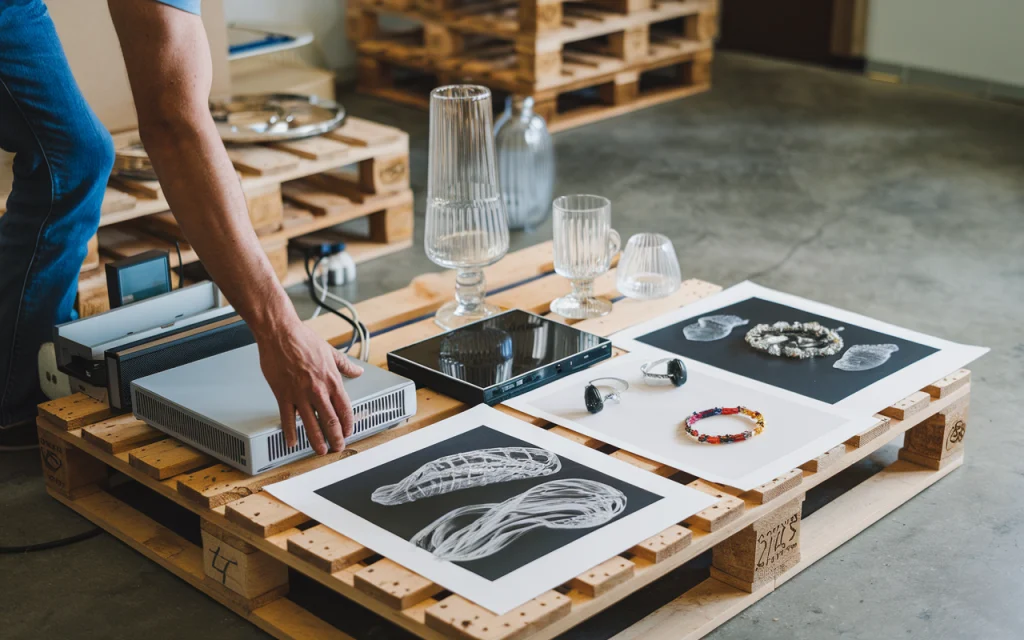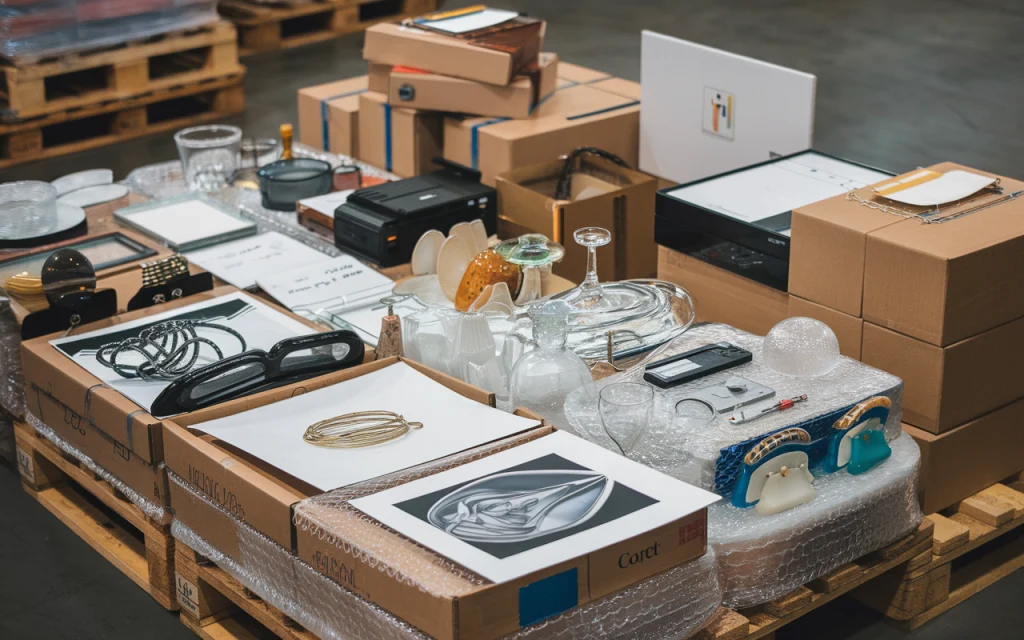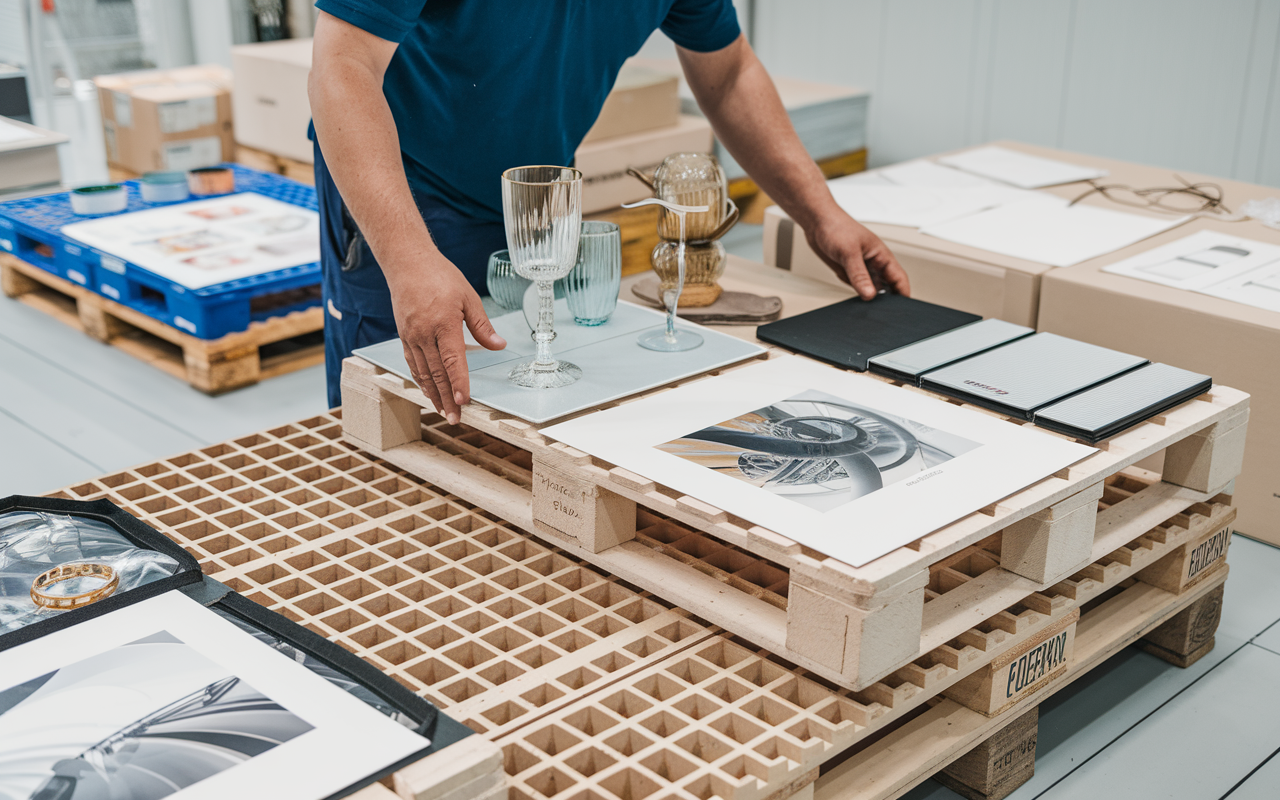Table of Contents
Shipping fragile items like glassware, electronics, art prints, and lightweight jewelry can be challenging. Ensuring that your items reach their destination without damage is crucial for maintaining your customers’ trust and avoiding costly returns. Proper palletizing is essential to protect your items during transportation. This article will explore the secrets to damage-free shipping, focusing on the best practices and materials for palletizing fragile items.
Why Palletizing is Essential for Fragile Items
When shipping fragile items such as computers, laptops, tablets, monitors, screens, TVs, LCDs, plasma displays, projectors, and perfume bottles, Palletizing for Fragile Items is a critical step. Proper palletization helps consolidate items, reducing the risks associated with transportation, such as breakage or mishandling.
The Risks Involved

The risks associated with shipping fragile items are numerous. Improper Palletizing for Fragile Items, poor packaging, and unsuitable packaging materials can lead to loss and product damage. Items like glass, iPhones, Android devices, art pieces, and antiques are particularly vulnerable. The importance of using specialized packaging cannot be overstated. Using unsuitable packaging can lead to loss, void insurance coverage, and attract the attention of thieves.
Selecting the Right Packaging Materials
Choosing the right packing materials is crucial for shipping delicate and fragile items. Different item types require specific materials to ensure they are protected during transit.
Inner and Outer Packaging Solutions
For inner packaging, consider using foam inserts, cardboard inserts, bubble wrap, and egg-crate foam to cushion and protect items. The outer packaging should include sturdy corrugated cardboard boxes, crates, and plastic bags to safeguard against moisture and other environmental elements. Using waterproof bags and shrink wrap is essential for protecting against water damage.
Securing Fragile Items on the Pallet
Securing fragile items on the pallet is as important as the packaging itself. The palletizing process involves using proper securing techniques to keep items stable and prevent movement.
Importance of Balance and Stability
Maintaining the center of gravity is vital when palletizing. Items should be placed evenly on the pallet to prevent tipping. Stretch wrap, plastic film, and appropriate strapping material are essential tools for securing items and maintaining balance. Consider using corner protectors, top covers, and reinforcement to further protect your items from impact during handling.
Best Practices for Handling and Labeling

Proper handling and labeling are critical to ensuring that fragile items are treated with care throughout the shipping process. Labeling and providing clear handling instructions can prevent mishandling.
Labeling Fragile Items
Using fragile stickers and clear labeling is essential for drawing attention to the delicate nature of your shipment. Labels should include details such as a description of the contents, quantity, serial codes, and specific handling instructions. This helps carriers understand the importance of treating your shipment with care.
Also Read: Pallet Procurement Marketplaces: How to Update Logistics In-Market
Providing Clear Handling Instructions
In addition to labeling, providing clear handling instructions is crucial. This includes instructions for unpacking, lifting, and moving the pallet. Clear communication ensures that everyone involved in the shipping process is aware of how to handle your fragile items properly.
Common Mistakes to Avoid in Palletizing for Fragile Items
Even with the best intentions, mistakes can happen. Avoiding common pitfalls in the palletizing process is key to ensuring the safe arrival of your fragile items.
Overloading the Pallet
One of the most common mistakes is overloading the pallet. Fragile items require space and proper support. Overloading can cause items to shift, leading to potential damage. Ensure that the weight is evenly distributed and that there is enough cushioning between each item.
Using Unsuitable Packaging
Another mistake is using unsuitable packaging for fragile items. Packaging materials that are too thin or lack cushioning can lead to damage. Always choose packaging that matches the fragility of the items being shipped.
The Role of Expert Palletizing Services

Sometimes, it’s best to leave palletizing to the experts. Expert palletizing services have the experience and know-how to ensure that your fragile items are palletized correctly.
Benefits of Professional Palletizing
Professional palletizing services offer several advantages. They understand the importance of using the right materials, maintaining balance, and securing items effectively. Their expertise can help reduce the risk of damage and ensure that your items arrive safely.
Choosing the Right Palletizing Service
When selecting a palletizing service, it’s important to review their practices and carrier reviews. Look for a service that has experience with fragile items and a track record of successful shipments. This will give you confidence that your items will be handled with care.
Closing Thoughts
Palletizing for Fragile Items is an essential part of the shipping process. By following best practices and using the right materials, you can protect your items from damage and ensure they arrive safely at their destination. From selecting specialized packaging to securing your items on the pallet, every step plays a crucial role in preventing damage. Whether you handle the palletizing yourself or rely on expert services, understanding the secrets to damage-free shipping will help you achieve successful shipments every time.
, palletizing fragile items is not just a step in the shipping process—it’s a critical factor in maintaining your reputation and ensuring customer satisfaction. By taking the time to properly package and palletize your items, you can prevent damage, reduce costs, and deliver your products with confidence.
FAQs:
What is palletizing for fragile items?
Palletizing for fragile items involves securely placing delicate goods like electronics, glass, and art on a pallet, using appropriate packaging and securing methods to prevent damage during shipping.
Why is palletizing important for fragile items?
Palletizing reduces risks of breakage by stabilizing items, distributing weight evenly, and protecting them from mishandling during transportation.
What materials should be used for palletizing fragile items?
Use materials like bubble wrap, foam inserts, corrugated cardboard, corner protectors, and stretch wrap to cushion and secure fragile items on pallets.

